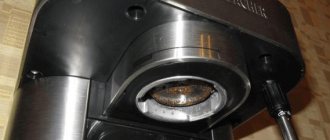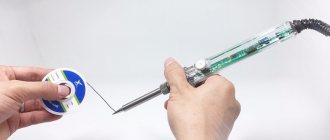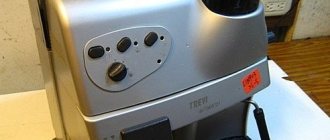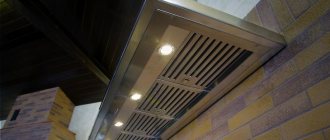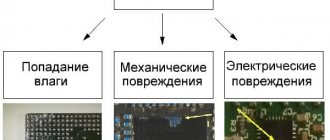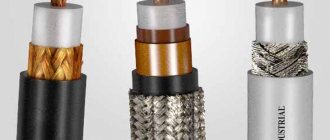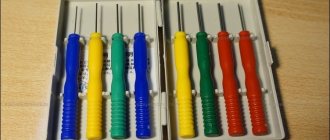Automatic coffee machines are very convenient to use: the drink is prepared in a matter of minutes, and you only need to put in a minimum of effort. Therefore, it becomes especially disappointing when a useful assistant in the kitchen breaks down. Repairing a coffee machine in service centers is a long and expensive undertaking. But sometimes the problem can be solved on your own, without resorting to the help of specialists. Let's look at the most common coffee machine malfunctions and how to fix them at home.
Why does a coffee machine break down?
Proper operation and care of the coffee machine ensures long-term service and stable operation. Unfortunately, in an office environment, coffee machines often work continuously, almost to the point of wear and tear, and it is not always possible to take good care of and thoroughly clean all the elements of its design: there is simply not enough time. However, regular maintenance, cleaning and general checks on the functionality of the coffee machine will significantly reduce the risk of breakdown. Here are the points you should pay attention to in advance.
- Low quality water is used to make coffee. If you use ordinary tap water, unfiltered, saturated with chlorine and other harmful impurities, sooner or later this will lead to the formation of scale and limescale on the internal parts of the coffee machine.
- Power outages. Periodic power failures and frequent switching on/off of the device also contribute to breakdowns.
- Wear of parts during long-term use. If the coffee machine has been serving you faithfully for more than a year, natural wear and tear of the structure may occur. Here it is better to consult a specialist: perhaps some parts still need to be replaced.
- Careless operation of the device, lack of regular cleaning. Cleaning your coffee machine is one of the most important maintenance components. Often, special cleaning products, descaling tablets, etc. are included with the device, but in certain cases, thorough manual cleaning is also necessary.
- Ingress of foreign objects into the structure, clogged filters.
These are just general reasons why your favorite coffee machine may suddenly break down. Next, we will highlight typical types of breakdowns that can occur with coffee appliances of various types and functionality.
Descaling
Remember, proper care of equipment is the key to its long service life.
To make coffee, you must always use purified or distilled liquid. However, sometimes there is a need to use hard water. Regular use of such a liquid often leads to the accumulation of lime deposits on the internal components of the apparatus. At the same time, settled dirt prevents the device from working properly, which can lead to accidental breakdowns.
Regular inspection of the equipment, as well as preventive maintenance, will help minimize the likelihood of scale formation on the walls of the coffee maker. To do this, you should clean the device from lime deposits at least once every three months.
To remove scale, you must perform the following steps:
- — dilute the detergent in accordance with the manufacturer’s recommendations;
- — fill the water container with the prepared solution;
- — place the coffee pot on the base heating plate;
- — turn on the device without inserting the filter;
- - turn off the coffee maker;
- — leave the device with the applied product for an hour;
- - restart the unit;
- - clean the coffee pot;
- — fill the tank with clean water;
- — turn on the device for final cleaning.
Remember, before resuming work, namely for brewing coffee, the device should be washed at least three times.
Why doesn't the coffee machine turn on?
If your coffee maker won't turn on, it could be due to many problems. Among them, the most common ones are most often identified.
- Electrical cable is bent or broken. To eliminate the defect, it must be replaced.
- When there are sudden power surges in the network, the fuse trips and the coffee machine stops turning on. In order for it to work again, this part must be replaced. It is recommended to use a stabilizer that will prevent damage to household appliances.
- If the coffee maker is running continuously, it may overheat. In this case, the thermal protection will work and turn off the device. In this situation, you just need to let the coffee machine cool down.
- With prolonged use, scale forms in the coffee maker and coffee deposits appear. All this can lead to open contacts. To start brewing coffee again, you need to thoroughly clean the device and restore the contacts.
- Control module failure. This defect is the most serious, and to correct it you will have to seek the help of professionals.
However, the problem is not necessarily with the coffee maker. First you need to check the following.
- Make sure there is electricity in the apartment. It is quite possible that the plugs in the electrical panel were knocked out.
- The machine may turn off due to clogged filters. They need to be cleaned or replaced. After this, the device will operate normally.
If all the electronics died
The most serious reason for lack of power is the complete failure of the control board or power board. If it breaks down, the car may smoke, after which it shows no signs of life . The main reasons are water ingress, network surges, and improper operation of the device. Another point is mechanical damage to the system during improper transportation. Repairs are carried out exclusively at the service center, as a full diagnosis and replacement/repair of damaged components is required.
If the coffee machine turns on but does not work
If, after being plugged in, the device shows signs of life, but refuses to brew coffee, the reason may lie in the open front door of the case . The first thing to check is whether all the doors of the device are closed. If the display starts to flash randomly when turned on, there is probably damage to the wiring. To fix the problem, it is necessary to replace the damaged section or the entire chain.
The coffee machine does not respond to button presses
In such a situation, you should immediately check whether there is water in the tank and coffee in the container. In addition, you need to make sure that the knobs and buttons are in the correct position. Sometimes a protection may be triggered that will not turn off until everything returns to its original position. If this does not work, it is recommended that you carefully study the instructions. It can help determine the cause of the breakdown. Most often, it can be indicated on the device display.
Sometimes, to eliminate a defect, you will need to remove the control panel and check the contacts with a tester. Perhaps the cause of the malfunction is that the buttons are dirty, causing them to stick and not work. In this case, you must thoroughly clean the control panel contacts and buttons.
If this does not help, then most likely the cause of the malfunction is an electronic failure. In this case, you should not try to repair the coffee maker yourself. You must immediately take it to a service center.
The coffee machine is noisy + water flows weakly
If the water from the machine does not flow well and noise is heard, the mesh is clogged or the filter of the horn is clogged. All you need to do is clean. There are special products on sale that can be used to clean grease from coffee machines.
You can also remove debris with regular toothpicks. If you choose this method, be careful not to scratch the parts.
The Philips coffee machine has another malfunction: it pours coffee poorly and is also noisy, but the reason is that the beans are ground too heavily. To fix this, you need to open the container with grain and make sure that the grind is really coarse.
If there is dust, select a different grain grind manually on the control panel.
Excessive noise can also occur due to a pump malfunction. Replacing the part will help.
Water flows out from under the car horn
Many owners of carob coffee machines are faced with such an unpleasant phenomenon as water leakage in the area where the carob is attached to the machine body. You can fix this damage yourself with a little effort. First, consider the O-ring that is located at the joint between the “spout” and the main body. Check the integrity of the O-ring. Most likely, it is clogged: there may be fat deposits, coffee waste, as well as foreign solid objects. If there is no blockage, but the ring is torn or there are cracks on its surface, it is necessary to replace this part with a new one.
Please note that the new O-ring must be identical to the old one, have the same characteristics and dimensions, otherwise it can cause damage and overheating.
Water leakage can also occur due to a clogged horn filter. Sometimes cake and coffee waste accumulate on it in a thick layer. Clean the filter in a timely manner and carefully replace it after cleaning.
By the way, similar malfunctions often occur with Delonghi coffee machines: during the process of making coffee or after finishing work, water appears under the unit. The manufacturer DeLonghi warns that you must read the instruction manual and also calls for careful care and regular cleaning of parts.
The coffee machine is leaking
If your Delonghi coffee machine has become faulty because it is leaking where the horn and body meet, then it is not a big deal. And you can even fix it yourself.
Most likely, the leak occurred due to a clogged O-ring, which is located in the place where the nose enters the body of the machine.
The blockage is fat, cake, grain, and so on. You need to disassemble the horn, remove the blockage and put the horn back together.
If the cause of the leak is that the seal is cracked or torn, you should buy a new one. It is important that the ring matches the characteristics of your coffee machine.
If these requirements are not met, the rubber may melt from high temperatures or may not be as elastic as it should be.
When troubleshooting such a malfunction of the coffee machine and doing the repair yourself, check the filter of the horn. It should be clean, without coffee.
By analogy, you can fix a leak in a coffee machine from any other manufacturer. Change the other seal as well. The main thing is not to be afraid and replace it in time, before water begins to flow through the wiring or floods the control unit.
If the machine stops pumping water, the piston above the teapot is probably damaged. You can also inspect and repair it yourself.
The coffee machine is very noisy
If, while making coffee, you notice that the coffee machine makes strange noises: crackling, hissing or whistling, then most likely the filter or mesh in the coffee horn is clogged. What to do in this case? Carefully disassemble the structure and clean clogged areas. The most convenient way to do this is with the help of special cleaning products for coffee machines and coffee makers.
To remove deposits from the mesh, use a regular toothpick or small brush, just be careful not to tear or scratch the thin material.
Perhaps you are using coffee that is too coarsely ground, and the pores of the filter simply cannot handle the particles, and the water pressure, in turn, causes cracks to form. Open the container where you usually put coffee beans and check how coarse the grind is. To facilitate this task, many coffee machines have a function for adjusting the grind size.
Another version of why the noise is too loud is the natural wear and tear of the built-in pump. In this case, you will simply have to replace the part.
Self-repair of coffee machines, tips, tricks
If a coffee machine breaks down, in some cases you can, by and large, figure it out on your own; to do this, you don’t even have to be a master in related fields, let alone a specialist in coffee machines. Although, everything is relative and some malfunctions of coffee equipment cannot be dealt with without preparation. We will try to suggest in general terms what to look for when a coffee machine breaks down, possible malfunctions or simply inattention during operation, and this happens, and often. For now we will consider problems in general, which are typical for all coffee machines; in the future, if we have time and desire, we will try to develop this topic more specifically by type of mechanism, device and model, but for now the most basic thing is what to do, how to deal with it and add links to which you can quickly find what you need for repairs. We hope this will be useful to someone.
- Coffee machine won't turn on
- The cord is damaged, the socket is faulty - check the socket with a tester or connect another working electrical device to it.
- There was a power surge in the electrical network and the protection elements in the electronics unit burned out.
- The switch or microswitches are faulty, cutting off the power supply to the control board.
- The primary winding of the low-voltage electronics power transformer has burned out - replace the transformer.
- One or more elements in the electronics unit: semistores, zener diodes, diode bridges, resistors up to the central controller / processor - without knowledge, you can only aggravate the breakdown. For repairs, contact specialists.
- The thermal protection on the boiler has tripped and cut off power to the entire coffee machine - you need to check all the protection elements on the boiler / heating element
…
…
- Coffee flows from one spout of the dispenser/holder
- Low pressure / slow coffee supply - check the pump, carry out a full technical service of the coffee machine
- The coffee machine is not installed level - level it horizontally
- The dispenser is clogged with coffee deposits - remove the dispenser and rinse with water. If the dispenser is not collapsible, replace it with a new one.
…
…
- When the coffee machine is operating, there is a suspicious cracking/creaking sound in the brewer
- If the brewing device is removable, it must be regularly removed and washed to remove ground coffee and other deposits.
- It is advisable, but not necessary, to lubricate the rubbing parts with a thin layer of silicone grease. As for lubrication, this is one of the cases when oil can ruin porridge. Since if there is an area where there is excess lubricant, then ground coffee will stick to it and this will be something close to abrasive materials that impede the movement of the mechanism. For this reason, it is better when the charger is simply not lubricated than when it is not lubricated correctly.
- Based on the point above - inspect the brewing device, its internal guides, if they contain old grease mixed with coffee, remove this deposit in any convenient way: disassemble and clean with napkins, without disassembling with cotton swabs and other convenient means at hand. It is useless to wash with water since the lubricant is silicone, thick and is not afraid of either cold or hot water.
- Another source of cracking noise, if it is in the brewer, is the loss of elasticity, or the shape of the seal of the piston o-rings. The ring simply needs to be replaced with a similar one designed for coffee machines
…
…
- The coffee machine grinds a little coffee / not a strong drink
- Clean the coffee grinder from old stuck coffee
- Replacing dull millstones with new ones and sharpening them is a thankless task and simply a waste of time. You will end up changing them anyway.
- Replace the auger with a more efficient one, which increases the speed at which coffee passes through the millstones. The average increase can be +20%
- Replace the millstones with more productive ones and set them correctly so that at the maximum load it does not spill from the charging chamber into the waste tray
- Waste coffee is not a tablet, falls apart into mush
- Insufficient amount of coffee, depending on the strength of the coffee, this parameter is 7-10 grams of dry coffee per cup. If the quantity is insufficient, then there is no way to compress such a small volume in the brewing chamber.
- Grind too coarse. With coarse grinding, not only will the waste fall apart, but the coffee will not be strong either. The consumption may be high but the efficiency is minimal. Set the grind to approximately the size of semolina, this will be the zero reference point and from this point you can adjust within small limits a little finer or coarser, and not only the richness of the coffee will change, but also the taste will reveal itself differently. Well, as a bonus, the waste briquette will fall out as an even and beautiful puck.
- The coffee machine requires descaling / Decalc
- Water hardness can be set in the service menu of the coffee machine. The setup procedure is described in the instructions for each coffee machine model.
- If the need for decalcification is indicated, it is advisable to carry out this procedure. The descaling process usually lasts about 50 minutes and is carried out automatically using special descaling products.
- The message about the need for decalcification can be ignored if the coffee machine does not block the coffee supply and does not beep. In this case, you must be sure that you use clean drinking water without minerals, salts and calcium. Otherwise, scale and other deposits may completely clog the boiler, in which case it will have to be replaced, and this may also negatively affect the operation of the solenoid valves.
- In coffee machines that are connected to a water supply, decalcification is carried out by removing and disassembling the boiler; usually these are professional and super-automatic coffee machines for cafes and restaurants. There are also office coffee machines with a water supply connection; usually they do not have a signal indicating the need for decalcification. Descaling in such coffee machines is carried out according to the instructions for the specific model.
- The coffee machine requires cleaning to remove coffee deposits / Clean
- In coffee machines with a built-in coffee tract cleaning system, when the CLEAN indication appears, it is necessary to start a cleaning program using special cleaning agents to remove coffee fats and deposits.
- In coffee machines that do not have a built-in cleaning system, but the dispenser (coffee supply spout) is removed, it is necessary to regularly remove it, disassemble it and wash it from coffee deposits. With regular use 1-2 times a month.
- The signal cannot be ignored! Otherwise, this will lead to the dispenser becoming clogged in the future and you will have to disassemble the coffee machine to clean it, and possibly change the dispenser.
- The finished coffee is drained into the waste coffee compartment
- Inspect the upper counter piston seal and replace it if necessary.
- Inspect the counterpiston housing for microcracks; if found, replace them
- A cream valve is usually installed on the upper counterpiston; it is necessary to inspect its body for cracks and inspect the seals (usually the cream valve is a spring with a locking element in the form of a fungus, a ball or a membrane)
- Carefully inspect the coffee pipe leading to the dispenser. Replace damaged elements.
- When preparing coffee / water does not flow from the dispenser, but into the tray
- In automatic coffee machines Jura / Bosch / Siemens / Melitta / Nivona / Rotel / Saeco - it is necessary to inspect the drain valve. The elasticity of the cuffs and a crack in the plastic elements can let water into the pan.
- In Saeco / Gaggia / Solis / Spidem / Philips automatic coffee machines, the seals on the boiler fitting may wear out or there may be a crack in the inlet fitting of the brewing unit.
- In Delonghi automatic coffee machines, inspect the seals of the upper counter-piston of the brewer, as well as the opaque part of the counter-piston for cracks.
- In automatic coffee machines Krups XP72… / EA8…. – inspect and replace, if necessary, the seals of the upper (white) counter piston of the charger, ensure the integrity of the cuff of the lower piston in the boiler, check for leaks and absence of cracks in the hydraulic press. If all else fails, the seals in the multivalve may be faulty or there may be a crack in its body.
- In capsule coffee makers, the seal in the capsule receiver is worn out or has lost elasticity / the capsule does not fit tightly. It is also possible that there is a crack in the capsule receiver housing.
- In carob coffee makers, the solenoid valve, drainage or emergency valve may not be working correctly. First of all, you can carry out decalcification; often this is not done in such coffee makers and scale can interfere with the proper operation of the valves. Removing scale can help solve the problem in half of the cases, unless, of course, the scale has damaged the working surfaces of the valves.
- When making coffee or washing, water flows onto the table
- A silicone or fluoroplastic high-pressure tube has burst - it needs to be replaced.
- A crack has appeared on one of the connecting adapters, the boiler valve or in the body of the steam/water tap. Replace with new ones and seals on them.
- If one of the seals in the hydraulic system is leaking, then you need to change all the seals in the hydraulic system and not just the one that is leaking, otherwise it will leak in different places every month. So isn't it better to change all the seals at once and forget about them for several years? To do this, we have repair kits for different coffee machines.
- If the multivalve in the coffee machine is leaking, carefully remove its cover; if cracks and broken outlets are not visible, then you need to treat the rubber seals of the ceramic valve and check the assembly. It still continues to flow - then there is a microcrack in the lid, it cannot be glued, only replacing the multivalve with a new one. BU multivalves can be used on KRUPS; it is advisable not to install a BU multivalve on all other coffee machines, perhaps the same thing will happen with it soon.
- No steam supply
- Check and clean the cappuccino maker nozzles to remove scale and dried milk.
- If the steam supply is weak, carry out the descaling process, removing scale can completely restore the normal operation of the steam generator and the entire system.
- Check the solenoid valves - those operating for steam supply, they may not open or close due to scale and other deposits interfering with the correct operation of the plunger. And also ring the electromagnetic coils to see if there is a break.
- If this system has a mechanical water and steam supply valve, make sure that it is not clogged, and if necessary, disassemble and clean it.
- Check the serviceability of the heating element on the steam boiler - if it is burnt out, replace the boiler.
- Check the proper operation of thermal fuses, thermostats or temperature sensor. It goes without saying that all contacts are reliable.
- There may be no voltage supply from the electronics unit to the heating element - tester, soldering iron in hand and go looking for the faulty element.
- The pump hums but the water does not pass through the hydraulic system
- If there is a water filter installed in the water tank of the coffee machine, remove it, this may be the problem.
- Often a coarse flow filter is installed before the pump; its body is made of transparent plastic; you need to check whether it is clean. If not, clean or replace.
- If the coffee machine has been idle for a long time, then the problem may be with the pump. The valve on the outlet fitting is stuck. Often it is enough to pry it off with an awl or a thin screwdriver and the pump starts working again.
- If the pump is turned on for a long time without water, trying to start the water supply, the cuffs on the working piston of the pump may be damaged. If the pump is dismountable, you can pick up a new ring and the pump will work; if the pump is not dismountable, replace the pump.
- Several elements of the pump may be worn out, the electric coil of the pump may be burnt out, or it will not produce the required water pressure - replace it with a new one.
- Depending on the region and water hardness, the hydraulic system may be clogged with scale, in particular the boiler. If the boiler is cast and the outlets are clean, but the blockage is somewhere deep, then most likely neither chemicals nor other cleaning will help - clean or replace the boiler.
- One of the solenoid valves may be faulty or clogged with scale. You can test the electric coils with a tester - replace faulty ones or change the valve. If the coil works, but the valve does not operate when voltage is applied, disassemble the valve, clean it and wash its elements except the electric coil in a decalcification solution.
- Check all mechanical valves in the hydraulic system, water flow sensor (flow meter), taps, rinse and clean the tubes of all contaminants, decalcify with a strong descaling solution. If water passes through the coffee machine very slowly and the problem is scale, that is, decalcification has never been done - BE CAREFUL AND CAREFUL!!! It is better to do the first decalcification manually. Prepare a decalcification solution in a full container of water, preferably not very concentrated, but as recommended by the manufacturer (1 effervescent tablet or 1 tablespoon if in powder form). Open the hot water supply tap until all the liquid has drained; do not allow long stops, maximum 1-5 seconds. Otherwise, flaking scale can clog the channels in the boiler, which can lead to the fact that nothing else will help except replacing the boiler. In case of severe blockages, in order to avoid calcium plugs in the boiler, you can repeat this express decalcification 2-4 times in a row through an open water supply tap, then turn on program cleaning in automatic mode, which lasts on average 30-50 minutes. In this way, critical scale deposits in the hydraulic system of the coffee machine can be cleaned.
The coffee machine does not recognize coffee
Have you poured beans or ground coffee into the tank, but the coffee machine still signals that it is empty and refuses to turn on? Most likely, the control unit is damaged, the internal motor is not working, or the coffee maker with funnel has broken down. Inspect the parts for damage and check for excess coffee dust inside the funnel or in the motor itself.
Replacing the engine is an expensive procedure, so in this case, you may have to think about buying a new coffee machine.
Another common malfunction: when coffee is poorly supplied to the tank, or the device does not supply it at all . Most likely, the problem is in the brewing mechanism: there is a blockage, waste, large particles, etc. have entered.
The main problems of coffee machines and coffee makers
- The water supply is interrupted. There is a blockage in the mechanism pipeline;
- The coffee has acquired an unusual smell or taste. In this case, you don’t always need to fix something yourself. Perhaps you just need to change the coffee tablets, and there is a very wide choice of them: Dolce Gusto - Dolce Gusto, Nestle, Jacobs, etc. Alternatively, the coffee machine filter may become clogged. Another factor affecting the taste and smell of coffee can be cheap plastic. During operation, some parts of the machine heat up to 130 degrees, which can cause the plastic to melt;
- Cold coffee. Most likely, your heating element has stopped working;
- The carob coffee maker does not work. This can be influenced by many factors: the motor is broken, the pump is not working, the power cable is broken;
- The dosage of water has been exceeded (most often found in capsule coffee machines). Most likely, the breakdown lies in the engine or in the timer operating circuit.
- The cooking time setting circuit does not work or the dosage per cup is incorrectly adjusted. Of course, you need to focus on the model of the device and its brand, but a common reason is the incorrect operation of the engine control circuit or one of its compartments.
If you are not sure that you can repair a coffee machine, then it is better to take it to specialists. If the device is under warranty, then there is no point in disassembling it at all; it will instantly lose the warranty.
Advice:
Why does the device not want to grind coffee?
The first thing you need to do is make sure there is grain in the machine container. If there is any, then you need to pour it out and remove the residue with a vacuum cleaner. After this, you need to set the grinding settings to the maximum position and pour a different type of coffee into the hopper. After this, you need to try brewing a couple of cups of coffee. If everything is fine, then it should have a matte finish.
Sometimes the cause of the malfunction may be that the previous beans were too fatty and the coffee maker simply could not cope with them.
If this does not help, then you will have to use special cleaning products for coffee makers. Using them does not guarantee troubleshooting, but it's worth a try. If this method does not help, then you will have to disassemble the device and thoroughly clean all the components. To avoid confusion during assembly, it is recommended to mark all parts with a marker.
The presence of water is not displayed
If the coffee machine does not respond to water, although the tank is full, most likely the problem is in the corresponding sensor - the float. You can check if the float is working as follows: pour water into the tank and see if the float floats to the top. If the sensor remains at the bottom, it may be flooded with water or clogged with debris. Try to clean the float workplace, and disassemble and dry the sensor itself. Did not help? Replace the element with a new one, which will become the entire repair.
The reason why moisture gets into the float and as a result of which the coffee machine does not see water in the compartment may be that you are pouring hot water. There is no need to do this, because... in this case, air comes out of the float and when the liquid cools, a vacuum occurs, which sucks water into the sensor.
Why doesn't the machine dispense coffee?
If the coffee machine does not pour the drink, then you need to pay attention to the flow regulator - most often the problem may be its malfunction. If the plastic arm responsible for supplying coffee is broken, it will not be poured as expected. Since this part is most often made of plastic, its breakdown may simply be due to regular use of the device. As a result, the material cracks and gets tired. In order for the equipment to function normally again, it is necessary to replace the part.
Another reason that the machine does not dispense coffee could be a dirty filter or metal piston. Therefore, if the machine starts pouring coffee slowly or does not supply water well, you just need to rinse the unit. If everything is done correctly, the coffee maker will start working normally and restore the water supply.
Cleaning the coffee machine often solves most problems.
If after this the coffee does not pour at all or pours poorly, you will have to clean the water supply path. Sometimes scale may form on it, or sediment may appear due to dirty tap water. In general, the tract requires regular maintenance, but few users do this. As a result, the device will dispense less coffee than usual. In this case, it is necessary to remove the brewing unit. It is behind it that the water supply path is located. It must be thoroughly cleaned and the coffee maker put back together. After this, the coffee should dispense normally.
No power supply
If the coffee machine does not work at all, we recommend that you first proceed by analogy with the instructions for repairing an iron yourself. First, check the integrity of the cord and the power at the outlet. After this, pay attention to whether the door of the coffee machine is closed. Most modern models have protection against starting when the door of the brewing unit is open and, perhaps, the equipment does not start for this reason. If you have not been able to find any obvious reasons, proceed to disassemble the case and, one by one, use a multimeter to test all sections of the circuit from the electrical cord to the thermal protection elements. Didn't find a problem? It is better to take a coffee machine that has broken down to a service center for repairs, especially if it is under warranty.
We also recommend viewing the repair instructions for a coffee machine that turns off:
How to solve the problem with equipment turning off
Error code on display
A fairly common situation is when an error signal is displayed directly on the coffee machine display. Refer to the operating instructions for the device. Perhaps there is a blockage, one of the sensors is faulty, or the mechanism is blocked for some reason. For example, for a Saeco coffee machine, Error 1 means the device is completely blocked, and Error 9 indicates a malfunction of the water heater sensor. Inscriptions similar to devices from Saeko also appear on models from other manufacturers.
Basic malfunctions of coffee machines
Popular device problems include:
- does not turn on, cooking programs do not start;
- the indicators are on, but the machine does not make coffee;
- the cappuccino maker does not make foam;
- the coffee grinder does not activate, resulting in low-grade grinding;
- water and milk are not supplied to the system.
These are the main malfunctions that make brewing a drink impossible.
Water does not heat up
If the unit does not heat the water, then the cause of this malfunction in the coffee machine (Saeco, Delonghi, Bosch, Nespresso, etc.) may be damage to the heating element or controller. To detect a breakdown, test both elements with a multimeter. If there is heating, but very weak, then perhaps the hardness of the water is to blame.
Nowadays there are special filter cartridges for sale to soften water and protect the structure from scale formation.
It is worth noting that machines from different manufacturers have their own cartridges.
The pressure in the horn decreased and noise appeared
If you see that the water from the coffee machine is flowing poorly, then the mesh or the filter itself is clogged. You can clean the coffee machine yourself. During cleaning, you can use special detergents. Special products for cleaning a coffee machine or coffee maker can be found in any store. You can remove debris with a toothpick. When repairing your coffee machine yourself, be careful. Be careful not to scratch the internal components.
If your coffee machine is noisy or does not pour coffee well, then the reasons for the breakdown of coffee machines are obvious. You should simply clean the clogged filter. If you see coffee dust when disassembling the coffee machine, then you should adjust the grind size.
Cappuccino maker does not work
If the machine has a cappuccino maker, then breakdowns associated with its operation are quite likely. For example, milk does not froth well or milk foam does not form. This is usually due to poor milk quality or clogged air channels that are responsible for creating foam. Milk must be pasteurized, with a fat content of 2.5%. Air channels can become clogged due to poor quality and untimely washing. After making coffee, do not forget to clean the cappuccino maker with clean warm water for a few minutes. If you see that hot milk is flowing instead of foam, contact a service center to have this part repaired.
Lost pressure in the coffee machine - main symptoms
In order to check the pressure in the car, you need to focus on the pump. Signs that there is a problem are:
- weak supply pressure for coffee drink;
- complete absence of coffee flow.
Unfortunately, this problem often occurs in capsule coffee machines that are out of warranty. The presence of a malfunction is easy to notice: just start making coffee and observe the intensity of its supply.
Another sign that there is no pressure in the coffee machine is a significant deterioration in the quality of the coffee and a complete absence of foam. Coffee deteriorates in the case of low pressure, when its value drops below 9 bar.
The filter in the water container is clogged
You need to replace the filter in the coffee machine very carefully, following all the prescribed instructions. This is especially true for capsule coffee machines, which require regular filter replacement. If the filter is installed incorrectly, it is customary to say that the car is “aired,” that is, a plug of air has formed in the system. As a result, the pump operates “idle”, and thus the device can easily fail. Replacing the coffee machine filter is carried out as follows:
- Stick your hand into the water tank.
- Grasp the filter housing with your hands and carefully pull it out.
- In some models of coffee machines, you need to unlatch the latches that are located above the filter.
Professional home repairs
For prompt maintenance of coffee machines from Delonghi, Krups, Bosch, Zelmer, Philips or other manufacturers, use the service center. In this case, you are guaranteed to receive:
- Home visit at a convenient time.
- Professional diagnostics on all parts and components of the coffee machine.
- All work in one visit.
- If necessary, replace faulty parts with high-quality original spare parts.
- Issue of warranty for installed parts and labor.
- If necessary, carry out a full service of the device, which will include cleaning, checking all seals, and, if necessary, replacing them.
- Optimal prices for services provided.
The big advantage of your contact will be that each specialist has special diagnostic equipment, a professional set of tools and the necessary original spare parts.
The coffee machine does not press capsules
The mechanism for punching capsules or tablets in capsule machines can also jam from time to time. Most often this occurs due to improper installation of the capsule. It is advisable to load it into the tank in such a way that it is installed on the piercing surface. After this step, lower the lever.
Do not forget that the coffee machine cannot fully compress the tablet if it lies unevenly and does not fall into the puncture site.
Does not grind grains
It also happens that the coffee machine does not grind coffee during operation. Here the repair comes down to the fact that you need to disassemble the case yourself, find the coffee grinder and clean it thoroughly. As a rule, high-quality cleaning helps solve the problem and repair this simple breakdown. A similar breakdown - when the coffee grinder does not pick up grains - can be solved very simply; you just need to correctly adjust the grinding degree. If even after this the mechanism does not pick up the coffee, it is better to contact a specialist.
Technical indicators of the coffee maker that affect the taste
The material of the horn body is of particular importance. If the part is made of steel, then when boiling water gets into it, the coffee tablet warms up well. Consequently, the grains release all the aromatic substances. In a plastic case, the drink turns out watery due to insufficient heating.
The boiler also creates pressure, only in this case steam for frothing milk. If the pressure in the coffee machine boiler rises, a safety valve opens and releases it. The temperature of the water in the coffee machine boiler depends on the amount of coolant inside.
In professional models it reaches 120 degrees. The container is usually filled to 70% so that excess pressure does not damage the assembly. The liquid in the boiler is not used to brew coffee - it serves as a heat source to heat the water that will be used to make espresso.
The amount of liquid in the boiler is an important indicator for the stable operation of the coffee maker. The larger it is, the better it holds the temperature and the better the brewing liquid heats up.
Dispensing tubes, of which there may be several depending on the performance of the unit, are the nodes through which boiling water flows to the holder. The more dispensing units, the more portions you can prepare at the same time. The pressure in these units corresponds to the required 9 bar.
Why is steam needed in a coffee machine - to supply it to an automatic cappuccino maker or a steam wand for manually frothing milk. The temperature of the steam in a coffee machine is usually the same as the temperature of water, so when using the wand you need to be careful not to direct the stream onto areas of the body.
Adjusting the pressure in the coffee machine
A sensor installed inside the unit prevents overheating of the unit if the equipment operates in continuous mode. When you turn on the machine, you can determine from its indicators that the unit is ready for operation.
In automatic models, the sensor can alert users to problems by displaying an error message. In manual and semi-automatic coffee makers, you need to independently monitor the sensor indicators.
There are 2 pressure gauges in the coffee machine - for the boiler and pump. After using steam to froth milk, the pressure in the boiler may drop below the permissible level. Monitoring the arrow readings, you need to wait until the machine restores functionality, that is, it heats the water to the desired temperature and the steam creates the required pressure.
The pump pressure gauge shows the pressure in the espresso brew group. In the operating mode of a good coffee maker it is 8 - 9 bar. When the equipment is disabled – 0.

